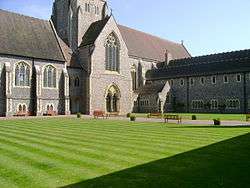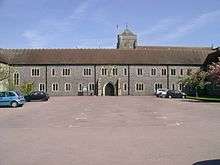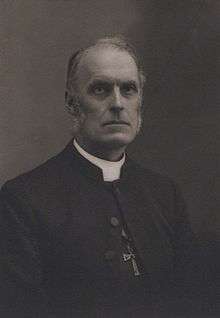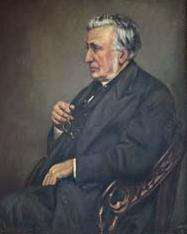Hurstpierpoint College
 | |
| Motto |
Latin: "Beati Mundo Corde" (Blessed are the pure in heart) |
|---|---|
| Established | 1849 |
| Type | Independent School |
| Religion | Church of England |
| Headmaster | Tim Manly |
| Chairman of Governors | Tony Jarvis [1] |
| Founder | Canon Nathaniel Woodard |
| Location |
College Lane Hurstpierpoint West Sussex BN6 9JS England |
| Local authority | West Sussex |
| Students | c.1,085 |
| Gender | Mixed |
| Ages | 4–18 |
| Houses | 13 |
| Colours | Red and White |
| Former pupils | Old Johnians |
| Alumni Website | www.theojclub.com |
| Affiliation | Woodard Corporation |
| Website | www.hppc.co.uk |
Hurstpierpoint College is an independent, co-educational, day and boarding school for pupils aged 4–18, located just to the north of the village of Hurstpierpoint, West Sussex. The College was founded in 1849 by Canon Nathaniel Woodard and is a member of the Woodard Corporation.[2]
History and overview
The school was originally established in 1849 as St John's Middle School, based in Shoreham. Its first headmaster, Edward Clarke Lowe, had worked with Woodard at Lancing College and stayed at Hurstpierpoint for 22 years until 1872. The school moved to Mansion House in Hurstpierpoint and then, thanks to the local benefactors the Campion family, on 21 June 1853 made its final move to its present site. Intended to resemble the collegiate system at Oxford and Cambridge, Nathaniel Woodard designed the College to have adjoining Inner and Outer quads and the chapel and dining hall adjacent to each other.
The school was most recently inspected by the Independent Schools Inspectorate in early 2011.[3]
Houses
The senior school comprises 13 houses including the recently added Wolf house and then, whilst retaining affiliation to their former houses, all students in their last year (Upper Sixth) join the 12th house, the co-educational day and boarding 'hall of residence', St John's House.
Traditions


The school still preserves ceremonies, which for the most part were taken from other schools such as Winchester College, in order to give the school a feeling of tradition back in its early Victorian days.
"Hurst" has traditionally performed a Shakespeare play every year since 1854, beginning with Richard III after the first headmaster, Dr Lowe inspired the first players onto stage. This means that Hurstpierpoint College boasts the oldest Shakespeare society in existence,[4] older even than that of the Royal Shakespeare Company which was not formed until 1875.[5]
The Hurst Johnian, the school magazine, founded in May 1858 is the vital source for the School's history. Its policy has been to maintain the annals of the school, and it continues to publish current reports and articles on the past. Evidence from the national archives suggests that it is the oldest school magazine in the country.[6]
Notable Masters
- Sabine Baring-Gould: Novelist and composer of hymns, the most notable being "Onward, Christian Soldiers". He was a Master of the College from 1855 to 1864. Baring-Gould had an eccentric reputation, and archives tell how he would teach with a bat on his shoulder and took weird holidays, bringing home a pony from Iceland, which lived for years in the North Field. Whilst the Hymn is thought to have been written in Yorkshire in 1865, a story recounts how Baring-Gould (known as "Snout") on one occasion gave a pupil of the College thirty-six (sic) cuts, and then washed his hands and sat down and wrote "Onward Christian Soldiers." A talented artist, he made and painted (well heraldically) the coat of arms of the Prince of Wales, which for many years appeared in the proscenium. Baring-Gould designed the cover of the Johnian (the College's publication), and designed the bookshelves and cases with their wrought iron, originally red and gold, in the Boys' Library. He also painted the window jambs with scenes from the "Canterbury Tales" and the "Faery Queen", and probably did work for the Fellows' Library. In 1860 he was one of the "Hurst Rifle Volunteers," who used to drill at the New Inn, which lead Hurst to be one of the founding Combined Cadet Forces schools.
- Thomas Fielden (musician): He was a famous Director of Music at Hurst, Charterhouse and Fettes, as well as a noted pianist, and Professor of Pianoforte at the Royal College of Music for over 30 years.
- Percy Henn: Noted clergyman and teacher in England and later Western Australia.
- David Whitmarsh: Academic at the University of Portsmouth.
Notable Old Johnians
Past students of Hurstpierpoint College are referred to as 'Old Johnians'; for details of notable alumni see Old Johnians.
Headmasters

- Edward Clarke Lowe (1849–1872)
- William Awdry (1873–1879)
- Charles Cooper (1880–1902)
- Arthur Coombes (1902–1923)
- Henry Bernard Tower (1924–1937)
- Walter Dingwall (1937–1945)
- Ronald Howard (1945–1964)
- Roger Griffiths (1964–1986)
- Simon Watson (1986–1995)
- Stephen Meek (1995–2004)
- Tim Manly (2005–present)
Southern Railway Schools Class
The school lent its name to the nineteenth steam locomotive (Engine 918) in the Southern Railway's Class V of which there were 40.[7] This Class was also known as the Schools Class because all 40 of the class were named after prominent English Public Schools. 'Hurstpierpoint', as it was called, was built in 1934 and was withdrawn in 1961.[7] Its nameplate is now housed in the School's Science Block.
References
- ↑
- ↑ "Woodard Schools - Independent, State Maintained, Academies". Independent, Academy and Maintained Education - Woodard Schools.
- ↑ "Hurstpierpoint College :: Independent Schools Inspectorate". Isi.net. Retrieved 2016-10-04.
- ↑ "Archived copy". Archived from the original on 2013-12-10. Retrieved 2014-03-04.
- ↑ "History of the RSC | A timeline | Royal Shakespeare Company". Rsc.org.uk. 2012-11-13. Retrieved 2016-10-04.
- ↑ "S. John's College, Hurstpierpoint Archive" (PDF). Nationalarchives.gov.uk. Retrieved 2016-10-04.
- 1 2 "Southern Railway Schools Class". Retrieved 2008-06-29.
External links
| Wikimedia Commons has media related to Hurstpierpoint College. |
- Hurstpierpoint College website
- schoolsguidebook
- ISI Inspection Reports - Prep School & Senior School
- Alumni Website www.TheOJClub.com
